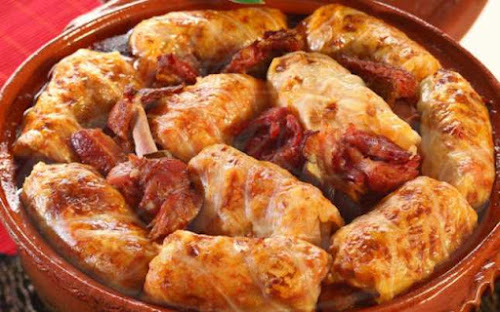Traditional Mouth-Watering Romanian Dishes that Everyone Should Try - Part III (Mains, Stews & Sides)
Traditional Mouth-Watering Romanian Dishes that Everyone Should Try - Part III (Mains, Stews & Sides)
Traditional Romanian Dishes Part I : Salads, Soups & Starters
Traditional Romanian Dishes Part II: Grilled Meats & Fish Dishes
Top 10 Reasons to Visit Romania
Sarmale – Romanian National Dish
SĂRMĂLUȚE ÎN FOI DE VIȚĂ – Sarmale With minced Goose in vine leaves
This is a cross between a fancy version of dolma – stuffed vine leaves and Romania’s sarmale above. This version stuffs the vine leaves with goose, instead of pork and covers it with a rich cream and bacon sauce. It was considered a Romanian delicacy during the interwar period (1919-1939) at a time when Romania was relatively affluent. It’s now being served up at some fancy restaurants around the country.
Bulz / Bulz Ciobanesc
Varză a la Cluj – Cluj Style Cabbage
Think of this like a cabbage hash. Shredded cabbage cooked with pork and sour cream. Cluj Napoca is a large city in northern Romania and this version of cabbage is popular there.
Pomana Porcului – Pork Feast
Ciolan afumat cu fasole – Army Stew (Beans & Pork Stew)
Drob de Miel – Lamb Haggis with Boiled Egg
Drob de miel is like a Lamb haggis meatloaf with a boiled egg down the middle so each slice has a circle of egg in the middle. Served at Easter referring to the sacrifice of Jesus, the Lamb of God.
Transylvanian Stews – tochitură ardelenească & Gulaș de cartofi cu afumătură
The tochitură ardelenească is a classic Transylvanian stew made with or without tomato (wine is the substitute for tomato) with the addition of vegetables like carrots, peppers, and potatoes. You may also find an alternative version called Gulaș de cartofi cu afumătură – which is a potato goulash with smoked ham added. Transylvania was previously part of the Austro-Hungarian empire before joining Romania in 1919, so it’s cuisine is more heavily influenced by that historic region.
Ghiveci cu pește – Fish Stew With Vegetable
Tochitură moldovenească – Moldovan Stew
Mămăligă – Romanian Polenta
Mămăligă is Romania’s polenta dish – made from boiled cornmeal. The ancient version of this dish, before corn arrived in Europe in the 16th century, would have been made from millet flour and is likely a remnant of Roman occupation. Corn grows well in the Danube Delta region of Romania and polenta is a traditional peasant food as an alternative to bread. Today, Mămăligă is served as a side along with many traditional Romanian dishes. Its dense texture is buttery and rich.














Comments
Post a Comment